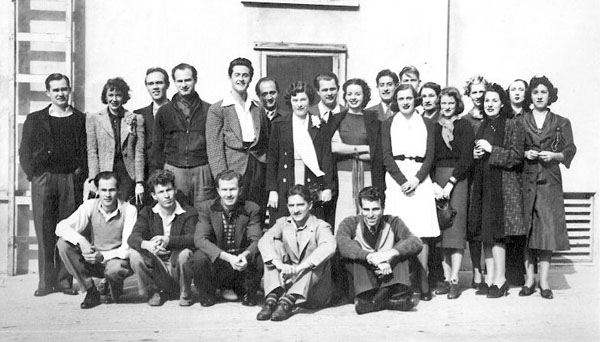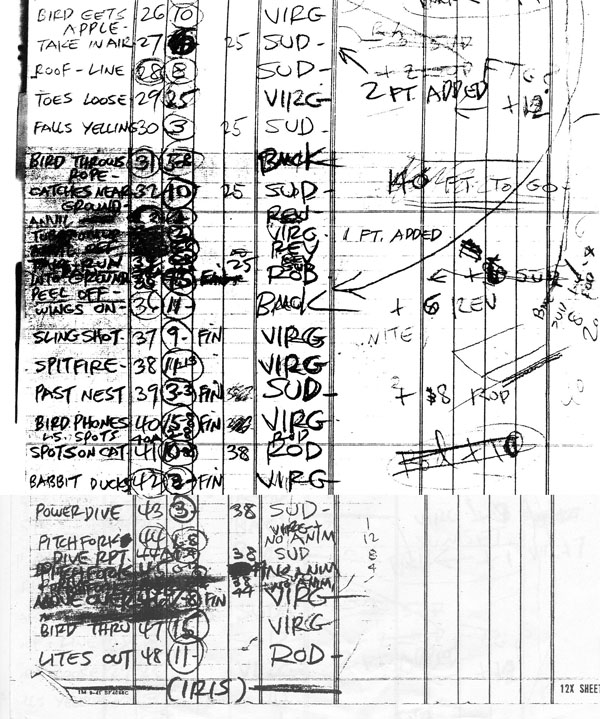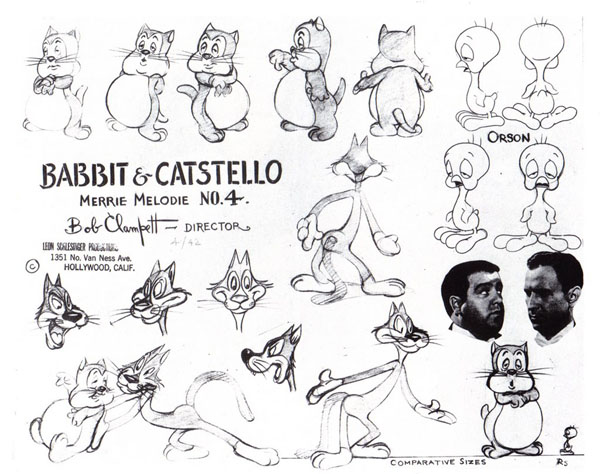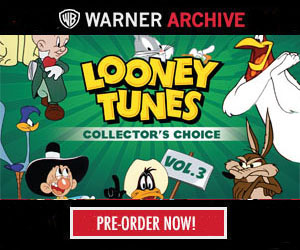
This week, we revisit Bob Clampett now five years ahead in his career, introducing a certain tiny little bird!
From his mid-’38 releases –starting with Porky’s Naughty Nephew – Clampett’s B&W Looney Tunes veered away from their genuine exuberance. Chuck Jones’ departure from the unit isn’t at fault, but the mandate to have Porky Pig be in every Looney Tune obviously exhausted Clampett’s use of the character. The talented animators in his unit -Norm McCabe, Bobe Cannon, Izzy Ellis and John Carey among them- pushed themselves to intensify their earlier spontaneous exaggeration. Evidently, Clampett felt handicapped with lesser animators with what was considered the cheap product for producer Leon Schlesinger.

Clampett’s B&W unit, taken around 1938
Ray Katz, Schlesinger’s brother-in-law and studio business head, housed the Clampett unit in a separate building from the main studio. Since Clampett had been writing his own stories, Katz felt that he needed to recruit some new gagmen. After a failed attempt with Howard Baldwin– only credited for the Hardaway-directed Porky’s Hare Hunt- high school friend Ernest “Flash” Gee and animation veteran Warren Foster arrived at the studio. Foster had previously served in the story department for Fleischer’s Popeye series, admired by Bob for their inventive gags. Clampett stated that he and “Flash” would “talk story” while playing games of ping-pong together. The B&W cartoons were hindered by a propensity for tepid gags and heavily referential humor, chiefly reliant on blatant radio catchphrases for a punch line. Aside from Porky’s Tire Trouble and Wise Quacks with Daffy Duck, Clampett was in autopilot until his late ’41 releases.
Farm Frolics and Goofy Groceries, both 1941 “gag-string” entries, were Clampett’s only color Merrie Melodies with the Katz unit. After Avery left the studio, he transferred to the Schlesinger building and inherited his team of brilliant animators, including Rod Scribner, Bob McKimson, Virgil Ross, et al. His first credit with his new unit was for Wabbit Twouble, begun by Avery, whose timing/humor clearly dominates the finished cartoon. The Cagey Canary, Aloha Hooey and Crazy Cruise were other Avery titles finished by Clampett, released around late ’41 and early ’42, yet neither director received credit. Once a staff member left the studio and a cartoon was left in production, their name was absent in the main titles.
Babbitt and Catstello, two catty caricatures of the extremely popular Abbott and Costello, were the nominal stars for A Tale of Two Kitties. The spotlight went to their foil, a little pink bird named “Orson,” according to the model sheets. The little bird first appeared in a brief spot gag in Wacky Blackout, one of Clampett’s last B&W Looney Tunes, with a “froggy” voice provided by Kent Rogers. Bob modeled the little bird after his own baby picture, and his more violent, aggressive personality is based around Red Skelton’s radio character, the Mean Widdle Kid.
His first words in Two Kitties that thrust him into stardom, “I tawt I taw a putty tat!” first appeared in a doodle Clampett sketched on MGM stationary to a musician friend. He scribbled a little bird next to Leo the Lion, with a word balloon which read, “I tink I taw a titty-tat.” The diminutive bird was renamed Tweety for his second cartoon Birdy and the Beast, after Clampett’s original idea of twin baby birds named “Twick n’ Tweet.” Of course, it would be grand for animation history if that original piece of stationary happened to surface. For the record, Phil Monroe stated in an interview (with Mike Barrier) that Clampett credited him with the line when Bob showed Phil his own sketch (which Bob had saved for years) of a canary perched on a limb uttering those now-famous words.
When he took over Avery’s unit, Clampett inherited principal animator Bob McKimson. Being the studio’s most influential artist, he was expert with solid drawing and graceful, subtle movements with his characters. It was Clampett’s great privilege to have McKimson on his crew. His introduction to Babbitt and Catstello deftly establishes their personalities. Catstello’s brief transformation as a gorilla, when he finds the nerve to eat the “defenseless bird,” is brilliant. McKimson also handles some great staging during the battle between the little bird and Catstello, and some technically complex sequences, as in scene 36, with the makeshift wings tied to Catstello’s arms.
 Rod Scribner’s distinct animation was more appreciated with Clampett’s cartoons than elsewhere at Warner’s. Around the time of Two Kitties’ production, Scribner and Clampett studied George Lichty’s loose, flowing lines in his Grin and Bear It newspaper comic. Bob often chose certain sequences in his cartoons for Scribner to “Lichty this a little.” This resulted in an unrestrained elasticity, used for a character’s inner emotions rather than a simple gag. His animation was just as essential to Clampett’s eccentric style as McKimson’s gentler work. Catstello’s reaction to the dizzying height from the ladder, Babbitt’s chastising Catstello for “clowning,” and their snarling pounce at the end, are important examples of the Lichty style Clampett and Scribner achieved.
Rod Scribner’s distinct animation was more appreciated with Clampett’s cartoons than elsewhere at Warner’s. Around the time of Two Kitties’ production, Scribner and Clampett studied George Lichty’s loose, flowing lines in his Grin and Bear It newspaper comic. Bob often chose certain sequences in his cartoons for Scribner to “Lichty this a little.” This resulted in an unrestrained elasticity, used for a character’s inner emotions rather than a simple gag. His animation was just as essential to Clampett’s eccentric style as McKimson’s gentler work. Catstello’s reaction to the dizzying height from the ladder, Babbitt’s chastising Catstello for “clowning,” and their snarling pounce at the end, are important examples of the Lichty style Clampett and Scribner achieved.
Virgil Ross animated for Clampett for only a year, claiming that he felt uncomfortable because his drawing/animation hadn’t met Bob’s expectations. He moved to Friz Freleng’s unit, where he spent the remainder of his career. Ross’ animation was earnest to the very end, given the small amount of scenes he was assigned for Two Kitties. The little bird’s fourth-wall smirk (a la silent comedian Harry Langdon) after removing Catstello’s “piddies” from the clothesline is marvelous.
Like Ross, Sid Sutherland was a former Lantz animator whom Avery brought over to his original “Termite Terrace” unit. His retreat from Clampett in 1942 marked the end of his animation career. Sutherland’s style is elusive. Looking closely, his drawing/animation is similar to McKimson’s, but lacks the solidity.
Revalee “Rev” Chaney (1915-85) is another unsung Warners animator, credited for brief sequences in this cartoon. His 1940 marriage certificate lists Jones animator Phil Monroe as a witness; indicative that he worked at the studio at that time, although it is uncertain how long his stint lasted. Chaney was a unit manager for industrial cartoons by 1949, and Broadcasting’s September 1956 issue announced his position as UPA’s assistant production manager under Ray Thursby. The low footage amount he is given in Two Kitties might explain why Chaney was never listed in the studio’s main credits.
The color styling in Clampett’s late ’42-’43 Merrie Melodies is gorgeous, and Two Kitties is no exception. Clampett attributed the richness to background artist Richard H. Thomas and layout artist Mike Sasanoff. Bob claimed to have drawn the layouts himself in this cartoon because he was temporarily without a layout artist. Babbitt and Catstello’s attempts to catch Tweety are set in “real time,” with each scene occurring at different times of the day – early morning, afternoon, sunset and night. This clever directorial approach manifested Clampett’s sense of ease with his new team of artists.
Enjoy this latest breakdown video!


Special Thanks this week to Yowp for additional information.



 DEVON BAXTER is a film restoration artist, video editor, and animation researcher/writer currently residing in Pennsylvania. He also hosts a
DEVON BAXTER is a film restoration artist, video editor, and animation researcher/writer currently residing in Pennsylvania. He also hosts a 



















































































Excellent essay!
I always thought that there was something missing from the gag at 3:06 when Catstello bounces up wearing the WW1 helmet and Tweety sticks a cigar in his mouth. After this Catstello is now punched through the helmet and wearing bandages the next time he bounces up. It’s as if there was supposed to be an exploding cigar gag that got cut for some reason.
It’s very possible that when the Blue Ribbon reissue of this cartoon came out in the 1950s, the gag in question (or some similar gag) was present in the version with original titles. I never noticed that before.
Maybe it was cut because they decided at the last minute that it was kind of redundant, because the scene ends with an explosion.
This one is a keeper. Thanks. When writing about Warner Animation it is important to always remember producer Leon Schlesinger said, “I don’t want quality and I don’t want it in the worst way. Let Disney make the chicken salad and win prizes. I will make chicken shit and I will make money.”
The budgets on these films were among the lowest in the industry. The incentive to do brilliant work was zero. Nonetheless, Tex Avery, Bob Clampett, Friz Freleng, Chuck Jones, Robert McKimson, Frank Tashlin and the staff that worked with them did brilliant work that is timeless. People writing about these films too often forget or ignore the fact the talent at Warner Animation was not encouraged to be talented. Thankfully, they did not need encouragement.
I completely disagree about your assessment of Bobs cartoons from 1938 to 1941. Bob was constantly experimenting with mood, staging and a large variety of characters and stories that weren’t sticking to the formulas of other cartoons of that time. He even experimented with custom acting and mannerisms–he caricatured what it was really like to live in his time, not just plugging in one note jokes and calling it a day. That’s real cartoon filmmaking, and even before he hit his peak years, he was making very creative films in spite of having the lowest budgets, least skilled animators and being forced to shove Porky in every film. And that’s not even getting into the variety of songs he featured in his films to liven things up or use to inspire funny ideas (I.e. The cutting between the sobbing cat and the rats in “We, The Animals Squeak”) something other directors would have chided as creatively restrictive or corny. Bob’s humor always firmly had tongue planted in cheek, though, and his directing skills made even the silliest ideas come out solid and stack up to the work of the other directors. It’s the execution that matters more than the gag itself, really.
Clampett did make a handful of misfires during his tenure, but that was mainly when he was working in someone else’s formula (I.e. “Porky’s Snooze Reel”, which is definitely one of his weakest films in spite of some funny moments).
John K. true-believer spotted!
Tweety was a fun character, but I’m a bit disappointed “Babbitt and Catstello” didn’t return. Perhaps the caricatures were too close?
As others will point out, Babbit and Catstello DID return – as mice – in Frank Tashlin’s A Tale Of Two Mice (1945) and Robert McKimson’s The Mouse-merized Cat (1946).
I love the “mystery” opening to this cartoon: We hear two characters arguing and fighting about something behind a fence; we don’t know who they are, what they look like, or what they’re fighting about, and then, at last, they come out in the open and we find out what the cartoon is about. Clampett really excelled at this way of “hooking” the audience, making us guess at what we’re going to see and then surprising us. Another great one is the opening of “The Great Piggy Bank Robbery,” where we start with a “pan” over a bucolic farmyard, cut to Daffy at the mailbox waiting impatiently for some unknown delivery that’s vital to him, and then we find out–it’s a Dick Tracy comic-book. Who would have ever imagined that was coming?
I always wanted to see an animation breakdowm sheet like this! Too bad they don’t exist for every WB cartoon. I confess that I had never heard of Rev Chaney until now.
Wow, Rev Chaney isn’t even listed on imdb. Always fascinating to hear about uncredited animators at WB.
For my money, “A Tale of Two Mice” is the funniest of the three Abbott & Costello cartoons. It was worth buying the western film “San Antonio” just to get this bonus cartoon, even if it was unrestored.
Here are some Blu-ray screen captures I took from “A Tale of Two Kitties” a few years ago: http://looneytunescaps.blogspot.com/2012/06/tale-of-two-kitties.html
Factoid: Rev Chaney died the same year I was born. As for the subject, I find most of Clampett’s cartoons to be comedy gold.
Rev Chaney was my dad. I just learned of this credit. 65 years after my birth…wow.
Sid Sutherland’s style seems to be tied in with a lot of staggered distortion drawings, like with Catstello hits the roof, and drybrush effects, like when Tweety or Orson zips back into his nest. McKimson didn’t use as much drybrush and kept his distortion drawings to a minimum. Don Williams in Art Davis’s cartoons used drybrush as an integral part of nearly all his scenes.
“… and being forced to shove Porky in every film.”
If SOME people don’t stop insulting my hero, Porky Pig, I will be called upon to kill them. (Believe me, it’ll hurt you more than it does me…)
The thing that bugs me about some of the Porky Pig cartoons (Looney Tunes) from about 1939-41, especially starting in 1940, is that Porky often has minor roles in his own cartoons… sometimes bordering on “cameo” appearances. “Slap-Happy Pappy,” “The Chewin’ Bruin,” “We, the Animals… Squeak!”, “The Sour Puss,” etc., and even some of the cartoons with Porky’s name in the title: “Porky’s Baseball Broadcast,” “Porky’s Snooze Reel,” “Porky’s Hired Hand,” etc. As a dyed-in-the-wool Porky fan, it bugs me.
I can understand that Robert Clampett may have grown a little tired of Porky, but it’s unfortunate. When I see a Porky Pig cartoon, I wanna see Porky! WAAAAH! Porky! WAAAAAAH! WAAAAAAAH! (To quote Bugs Bunny: “Ain’t I a stinka?”) WAAAAH!
Well, at least we have stuff like “Porky in Wackyland,” “Wholly Smoke,” “Little Beau Porky,” “Naughty Neighbors,” etc.
P. S. “Sid Sutherwand.”
Chuck Jones also ended up loathing Porky. He channeled his feelings about the pig as a lead character when he made some of his best pictures during the 1950s with Porky as a foil for Daffy or Sylvester.
Porky single-handedly saved WB from being a footnote in animation history, so I’m a big fan of his. It doesn’t hurt that he was in some of the funniest cartoons of the ’40s and early ’50s (“The Ducksters” in particular is brilliant).
My first ever classic Warner Bros. cartoon! Thanks for sharing!
One of my favorite lines from this cartoon, which is lost on most people these days, is “Oh, if the Hays Office would only
let me I’d give him the Bird!”
YOU SHALL DO HATCH UP YOUR TROUBLES NEXT